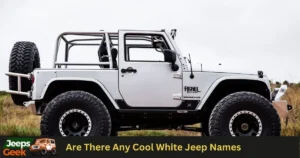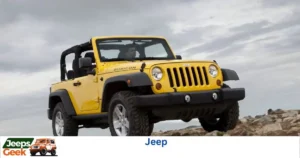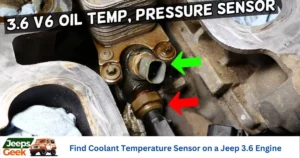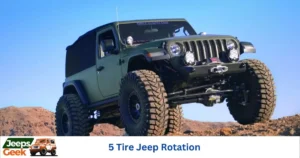Imagine you’re cruising in your Jeep, enjoying the ride, when suddenly a message on your dashboard says, service forward collision warning. Not the news you want when your Jeep’s high-tech stuff is supposed to keep you safe, right? So, what’s up with the Forward Collision Warning not doing its job?
This article explains how Forward Collision Warning systems function, their role in enhancing road safety, and how they alert drivers to potential dangers. We’ll explore why glitches might occur and share practical solutions to help you fix any issues with your FCW.
Join me as we delve into the mechanics of Forward Collision Warning in your Jeep, ensuring you can enjoy the road safely with this fantastic technology. But before we dive in, let’s get a basic understanding of how Forward Collision Warning works.
What Is Forward Collision Warning?
Forward Collision Warning (FCW) is an advanced safety feature that enhances vehicle safety by alerting drivers of potential collisions with vehicles or obstacles. Utilizing sensors and cameras, FCW monitors the road ahead and provides timely warnings to drivers, helping to mitigate or prevent accidents.
Forward Collision Warning (FCW) is like your car’s superhero for safety. This excellent feature helps you avoid crashes and keeps you on high alert while driving. Think of it as your car’s superpower!
Here’s the cool part: FCW is like a high-tech system with sensors placed strategically in the front of your Jeep. It’s got eyes, in the form of cameras and radar, keeping a close watch on the road. Whether a car suddenly changes lanes, a person crossing the street, or some object in your way, these sensors ensure your path is clear.
When FCW senses a possible collision, it doesn’t just stay quiet. Nope, it makes sure you know something’s up. You’ll get visual alerts, sounds, and even a little shake – like a friendly tap on the shoulder, but from your car. It’s your car’s way of saying, “Hey, danger ahead!”
But wait, there’s more! FCW doesn’t just warn you; it goes a step further. If it thinks a crash is about to happen and you’re not reacting, it can talk to the emergency brake system. This superhero move helps your car automatically apply brakes to avoid a collision.
And guess what? You can customize FCW! It’s like having a personal setting for your superhero. You can choose how sensitive you want it to be – whether it gives you a heads-up from far away or waits until things are close. You’re in control!
So, now that you’re buddies with Forward Collision Warning, let’s find out what “Service Forward Collision Warning” means. It’s like the next chapter in our superhero story!
Read also: ACC FCW Limited Functionality
What Does Service Forward Collision Warning Mean?
If you encounter the message “Service Forward Collision Warning” in your Jeep, you must pay attention and understand it. This alert is not a casual warning on your instrument cluster; it’s telling you that the safety net of your vehicle is facing a potential internal hiccup. You can be in trouble anytime if active braking is enabled in your Forward Collision Warning settings.
You may also see the ACC FCW Unavailable Service Required or ACC FCW Limited Functionality warning on the instrument cluster. It indicates an internal fault within the Forward Collision Warning (FCW) system. This issue is more prominent in the 2021 & 2022 Jeep Renegade, 2022 Jeep Compass, Jeep Grand Cherokee, and Jeep Wranglers.
Now that you know the error, let’s determine why your Forward Collision Warning light is on.
You need to address the issue promptly while you can drive the vehicle under normal conditions despite this warning. The FCW system, integral for proactive collision warnings and prevention, may not be fully operational, leaving a critical safety feature temporarily disabled.
Have your car checked as soon as you encounter this warning. Given the complexity of modern automotive safety systems, you should rely on the expertise of professionals to ensure diagnosis and appropriate resolution.
Although the vehicle is still drivable, you should exercise caution and remain conscious of the potential limitations of the Forward Collision Warning system. While routine driving is fine, you should avoid scenarios where the FCW system may be crucial, such as high-traffic areas or situations prone to sudden obstructions.
What Are the Reasons Behind the Service Forward Collision Warning?
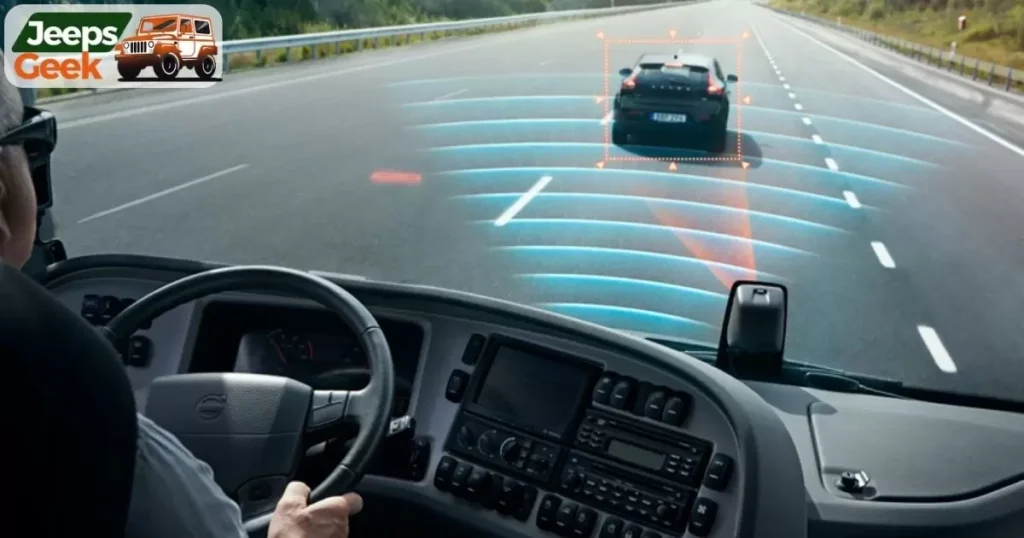
In vehicle safety, the Forward Collision Warning (FCW) system is crucial to avert impending dangers. Yet, when a Service Forward Collision Warning message pops up on your dashboard, it throws a wrench into this essential system.
Let’s delve into the likely reasons triggering this warning and discover remedies to ensure your safety features remain in top-notch condition.
1. Dirty Front Sensor
A common cause of the service warning is a dirty front sensor. Accumulated dirt or debris can obstruct the sensor’s functionality, leading to inaccurate readings and false alarms. Regular cleaning is necessary to ensure optimal performance.
Use Warm water, car shampoo, and a soft microfiber cloth to restore that sensor. But remember, be gentle – sensors aren’t fans of rough treatment.
2. Broken Sensor
A more severe issue could be a broken sensor. Physical damage to the sensor can disrupt its ability to detect obstacles, necessitating sensor replacement to accurately restore the FCW system’s effectiveness.
Sensors are delicate creatures that can take a beating, especially from overheating or accidents. If the warning won’t budge and you suspect a damaged sensor, you might need to swap out the supporting bracket or the wheel speed sensor.
Pro tip: If you’ve got a warranty, go for the professional replacement route. Head over to the dealership for a thorough check-up and, if needed, a reset.
read also: Service Passive Entry System
3. Misaligned Sensor
Misalignment of the sensor due to external factors or previous repairs can also trigger the service warning. Ensuring proper alignment is crucial for reliable collision warnings and avoidance.
A sensor that’s out of whack can mess with your Forward Collision Warning system. It might be time for a new sensor if you can’t get it back in line. Windshield changes, accidents, repairs, or even factory oops can throw a sensor off course. In these cases, a pro realignment or a new sensor could be the fix you need.
4. Faulty Connection
Issues with the sensor’s connection, such as loose or damaged wiring, can lead to communication breakdowns and trigger the service warning. Sometimes, it’s as simple as a faulty connection causing the Forward Collision Warning glitch. If your car’s been worked on recently, someone forgot to plug the sensor back in, or the connection might need to be fixed.
Head back to the last shop where the work was done for a free check. They can quickly spot and fix this oversight.
5. Calibration Issues
Proper calibration of the FCW system is essential for accurate threat assessment. If the system is not calibrated correctly, it may provide false warnings or fail to alert drivers when necessary.
Sensor calibration problems, often triggered by events like getting cut off by another car, can make the warning pop up. If your dealership can’t recalibrate, they might suggest a replacement.
If they go for a replacement, it’s essential to get it done promptly to ensure the system works.
6. Factory Defect
Sometimes, the service warning may be attributed to a factory defect in the FCW system. Manufacturers should be contacted to address such issues, potentially involving system replacement.
In rare cases, the Forward Collision Warning trouble might stem from a factory defect in the FCW system. This could be missing components during assembly. If the issue persists despite trying various fixes, Manufacturers should be contacted to address such problems, potentially involving system replacement.
7. Driving Jeep in Bad Weather
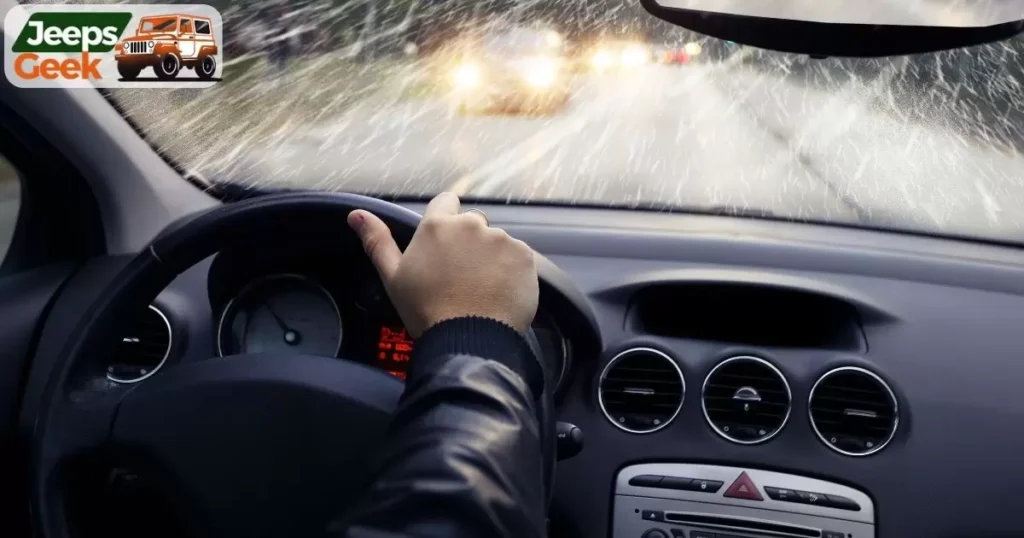
Your system’s reliability can take a hit in harsh weather, triggering the Service Forward Collision Warning. Heavy rains or snowfall can mess with sensor visibility, and water or ice near sensors, especially after heavy rain or car washes, can mess with the system.
Bad weather is unpredictable, so addressing these disruptions beforehand is tricky.
When the weather’s acting up, be cautious. If visibility is bad, take a break until things clear up or the system gets back on track. Unfortunately, there’s no direct fix because it depends on unpredictable weather. Patience is key; the system should return to normal once the weather improves. Just acknowledge that nature does its own thing and plan accordingly.
8. Camera Malfunction or Reduced Visibility
In the FCW system, the forward-facing camera plays a crucial role. But seeing a “Service Forward Collision Warning” on your dashboard could mean trouble for this essential part.
Sometimes, the forward-facing camera might struggle during calibration, causing it to malfunction. The camera module could also fail prematurely. External factors like dirt or moisture can mess with the camera near your rearview mirror, making it give off false readings. Moisture creeping into the camera module can mess up its functions and trigger incorrect warnings. Plus, getting replacement parts for these camera modules might take a while, causing delays in fixing the problem.
When this happens, it’s dealership time. If calibration problems stick around, the dealership might have to order a new part, and the wait could be annoying. Swapping out the camera module will fix the malfunction if your vehicle is still under warranty.
Do a quick check for any dirt or moisture on the camera lens. If you spot anything, give it a gentle cleaning. And if humidity is causing issues, let the area dry out completely. In severe cases, you might need a pro to tackle moisture problems and replace the whole camera module. Make it a habit to inspect the camera during your regular maintenance visits to catch any issues early on.
9. Blocked or Faulty Radar
The radar is like the superhero in your Forward Collision Warning (FCW) system. But, if you get a message saying “Service Forward Collision Warning,” chances are it’s pointing to a hiccup in the radar department.
A glitch in the radar can make your car hit the brakes unexpectedly, even when there’s no immediate danger. Shared fuses might be the culprits causing a ripple effect and messing with the radar.
Weather can also throw a wrench in the works. Heavy rain, snow, or mud can mess with the radar’s senses so it might take a break for safety reasons.
And here’s a quirky one – if there are stickers on your bumper or you’ve got a fancy aftermarket license plate holder, they might be blocking the radar’s view. Even too much paint on a replacement bumper cover can make the radar see things that aren’t there.
If your radar is acting up, it might be time for a replacement. But hey, if your car starts braking out of the blue, you want to jump in quickly to avoid any safety issues.
Start by checking for blown fuses – they might be the root cause. If it’s a shared fuse issue, swap it out and tackle the real problem.
Keep an eye on the weather, too. When things get back to normal, the system usually perks up again. It’s sensitive to the weather changes.
Take a peek at your bumper, remove any stickers, adjust the license plate, and ensure nothing is blocking the radar’s way. Keep the paint thickness in check if you’re doing repairs or changes.
It’s all about giving your radar a smooth ride to keep you safe on the road.
10. Battery Issues
When you encounter a Service Forward Collision Warning message, the culprit might be linked to issues with your vehicle’s battery.
A not-fully-charged auxiliary battery can throw a wrench into your vehicle’s electronics, including the FCW system. Whether it’s the main battery or the extra one, you might start seeing error messages and glitches if they need to be up to snuff.
Watch for problems like inadequate charging or corrosion on the battery posts and sensors. These can be triggers for system errors. The Intelligent Battery Sensor (IBS) also plays a role – if it’s acting up, it can mess with the flow of electrical info, causing hiccups in the FCW system.
As batteries age, they can lose their oomph, affecting their ability to provide consistent power. Weak batteries might appear as errors in various vehicle systems, including the Forward Collision Warning.
To tackle this, give the primary and auxiliary batteries a trickle charge to ensure they’re fully juiced. Also, take a moment to clean the Intelligent Battery Sensor (IBS) on the battery post for a solid electrical connection. Keep an eye on your battery’s health, and if you notice any signs of weakness, deal with them pronto.
By maintaining a solid connection, you’re boosting the accuracy and reliability of electrical signals, cutting down on the chances of errors. Regularly checking in on your battery lets you catch any issues early, stopping potential hiccups in the Forward Collision Warning system.
11. Software Glitch
The Service Forward Collision Warning message might pop up because of a software hiccup.
Those recent computer updates can sometimes sneak in bugs that mess with the Forward Collision Warning system when they try to boost the overall performance. These software glitches might throw off the calibration of the FCW system, making it wonky.
And here’s a heads-up: if your software lags in updates, these glitches can also be a culprit.
If these software issues just won’t quit, it’s best to let the dealership do some deep digging with their diagnostics. They can figure out what’s causing the trouble and fix it from the root.
After any computer updates, keep a sharp eye on how the system behaves. If something seems off, give your dealership a heads-up. They can take a look and tweak the software to ensure it plays nice with the Forward Collision Warning stuff, so you’re less likely to get those pesky glitches.
You can unplug the battery and let it chill for a bit. It’s like a soft reset that might help shake off those software glitches causing those not-so-fun warnings.
Pros and Cons of Service Forward Collision Warning
Understanding the advantages and disadvantages of Forward Collision Warning is crucial for making informed decisions about its implementation and usage.
Pros
- Enhanced Safety: FCW provides an additional layer of safety by alerting drivers to potential collisions, allowing for timely responses.
- Reduced Accident Rates: Studies suggest that vehicles with FCW experience lower collision rates, contributing to overall road safety.
- Adaptive Technology: Advanced FCW systems can adapt to different driving conditions, providing warnings tailored to specific scenarios.
- Insurance Discounts: Some insurance providers offer discounts for vehicles with advanced safety features like FCW, potentially lowering overall insurance costs.
Cons
- False Alarms: FCW systems may occasionally trigger false alarms, causing drivers to become desensitized or ignore warnings.
- Dependency Concerns: Overreliance on FCW may lead to decreased vigilance among drivers, assuming the system will prevent all collisions.
- Maintenance Costs: As the service warning indicates, addressing the issFCW system the service warning can involve additional maintenance costs.
- Limited Effectiveness in Certain Conditions: Adverse weather conditions, extreme environments, or certain types of obstacles may limit the effectiveness of FCW.
Unlocking the Future Scope: Service Forward Collision Warning Technology
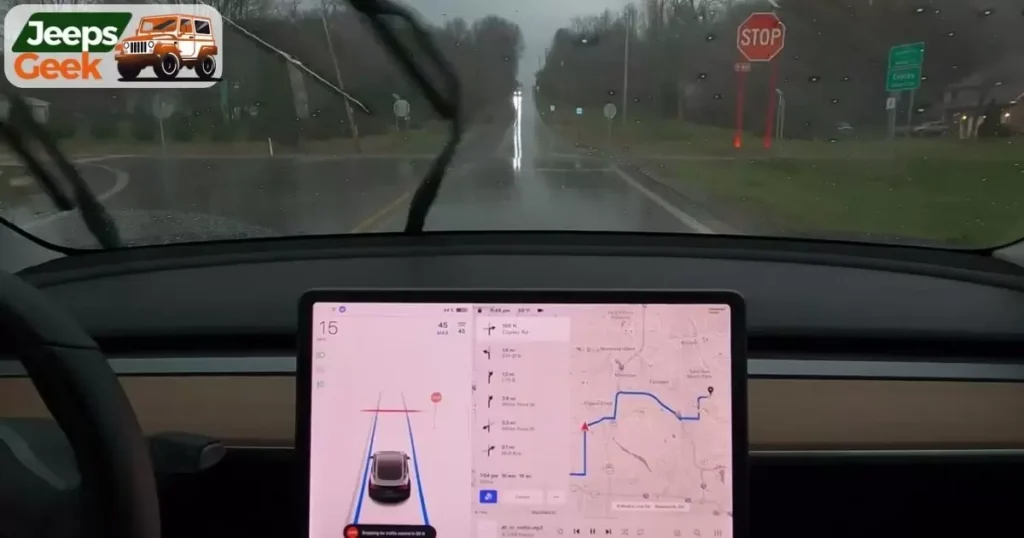
As automotive technology continues to advance rapidly, the future of road safety lies in innovations like Service Forward Collision Warning (SFCW) systems. SFCW has emerged as a pivotal component in the evolution of automotive safety, offering a glimpse into the promising future of collision prevention and driver assistance.
Advancements in Machine Learning and Artificial Intelligence:
The future of SFCW lies in harnessing the power of machine learning and artificial intelligence. These technologies enable SFCW systems to continually improve their ability to detect and predict potential collisions, making split-second decisions that can mitigate or even prevent accidents.
SFCW will adapt to diverse driving conditions and environments as algorithms become more sophisticated.
Integration with Vehicle-to-Everything (V2X) Communication:
The future scope of SFCW extends beyond individual vehicles to a connected ecosystem. By integrating with V2X communication networks, SFCW systems can exchange real-time data with other vehicles, infrastructure, and pedestrians.
The collaborative approach enhances the overall effectiveness of collision warning systems, creating a safer and more responsive driving environment.
Augmented Reality Displays and Human-Machine Interaction:
Imagine a future where SFCW not only warns drivers of potential collisions but also does so in a way that seamlessly integrates with augmented reality displays.
Visual cues and alerts can be projected directly onto the windshield, providing intuitive guidance to the driver.
Human-machine interaction will play a crucial role in ensuring that SFCW systems are practical and user-friendly.
Adaptation to Autonomous Driving:
As the automotive industry progresses towards autonomous driving, SFCW will be a fundamental component of these advanced systems. The future scope involves the seamless integration of SFCW into self-driving vehicles, which will act as a crucial layer of safety, helping autonomous cars navigate complex traffic scenarios and avoid collisions.
Answers To Key Questions
What is service forward collision warning?
Service Forward Collision Warning refers to the need for maintenance or repair in the system responsible for forward collision warnings in a vehicle. It indicates that the system requires attention or diagnosis by a qualified technician.
Why is my forward collision warning light on?
The forward collision warning light is likely on because the system has detected an issue or malfunction. Common reasons include sensor obstruction, system calibration problems, or a malfunction in the forward collision warning components.
How do I turn off forward collision warning?
Turning off forward collision warning varies by vehicle make and model. Typically, you can find the option in the vehicle settings on the dashboard or through the infotainment system. Refer to your vehicle’s manual for specific instructions.
What does the forward collision warning system do?
The forward collision warning system is designed to alert the driver of an imminent collision with the vehicle ahead. It typically uses sensors, cameras, or radar to monitor the distance and relative speed between your car and the one in front. If a potential collision is detected, the system activates a warning, such as visual or audible alerts, to prompt the driver to take corrective action, like braking or steering, to avoid the collision.
Final Words
The Forward Collision Warning (FCW) system is not merely a feature but a vigilant co-pilot. It actively minimizes potential hazards to keep you and your loved ones safe. The occasional appearance of the Service Forward Collision Warning message may cause momentary concern. Still, if you understand the intricacies behind this notification, you’ll find manageable solutions.
Service Forward Collision Warning is more than a message; it’s a prompt for a thorough check. Quick attention to any issues ensures your safety features work seamlessly, giving you confidence on the road.
Now that you have a handle on sensor, camera, radar, and battery matters, the process should be more straightforward. Regular cleaning, timely fixes, and professional help keep your safety features like the Blind Spot Alert intact and ready for action.
Software glitches can be tackled, too. Keep an eye on updates, try a soft reset with your battery, and seek professional advice when needed. These steps ensure your collision prevention features work reliably.
Understanding these challenges turns uncertainty into informed action. Embrace a proactive mindset, use available solutions, and drive confidently, knowing your Jeep’s safety features are there to keep you secure on the ever-changing road.

Meet James Wilson, the driving force behind “Jeeps Geek.” As a dedicated Jeep enthusiast, I’ve navigated the trails, tinkered under the hood, and conquered every off-road challenge. Join me on the Jeeping journey where I share insights, troubleshoot issues, and celebrate the thrill of the open road.







